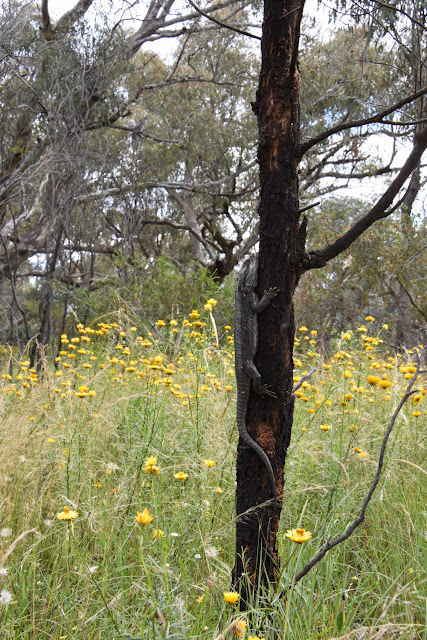Snowy Mountains - details
Lichen and bark.
Lichens growing in the socket left where a limb once grew on a Snow Gum Eucalyptus niphophila.

Longhorn tracks.
These branches of a snow Gum have been killed by borers, the larvae of a longicorn beetle Phoracantha sp. They burrow beneath the bark of the living stems, the tree dies, the bark peels away and the finger wide furrows of the larvae burrows are exposed. Meanwhile the larvae have emerged and flown off to infect another tree.

A tangle of branches.
Lichens growing on the dead branches of Snow Gums killed by the big fire of 2003.

A tangle of leaves.
High on an alpine slope, looking through a low mat of Herbfield Celmisia Celmisia costiniana. The shine is created by the multitude of tiny hairs on the leaves, which help protect the plants from frost.

Stars in an alpine stream.
Alpine Marsh Marigold Caltha introloba grows in wet flushes below snow patches. It likes to have its feet wet and doesn't have much of a hold in the gravel beds.

Everlasting awakening.
A cushion of an alpine everlasting, Alpine Sunray Leucochrysum albicans. In a few weeks there will be tall stems with daisy-like heads sprouting from this tight mass of silvery woolly leaves. This is the form that the plant adopted to survive under the winter snows.

Xanthoria orange.
A tell-tale streak of Xanthoria sp. lichen growing on granite tor high on the summit ridge of the mountains. These lichens only grow where there is localised nitrogen enrichment. In this instance, there was a streak of it below a slanting crack in the rock, only a flat hand wide. The presence of the lichen hints that nitrogen was dropping out of the crack - probably very small amounts over many many years. That could have been from moth droppings, from aestivating Bogong moths Agrostis infusa.

Water lines.
Meltwater forms runnels on the surface of the old snow patches, then drips from the lip and into a stream below.

Old snow.
Cracks opening up on a long-lying snow bed.































